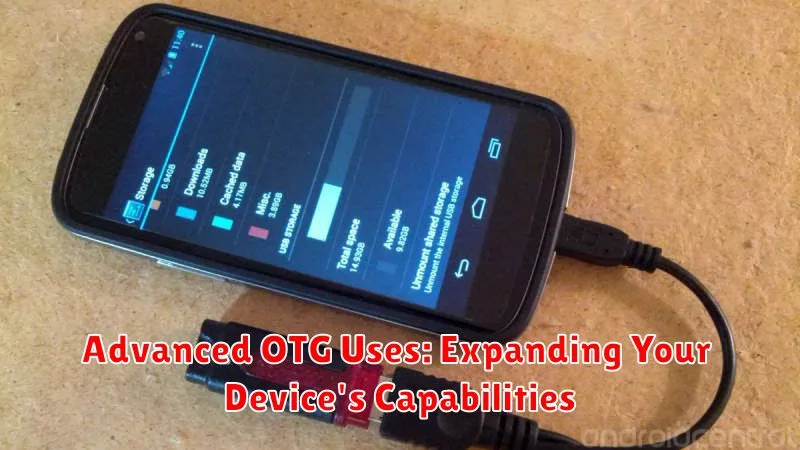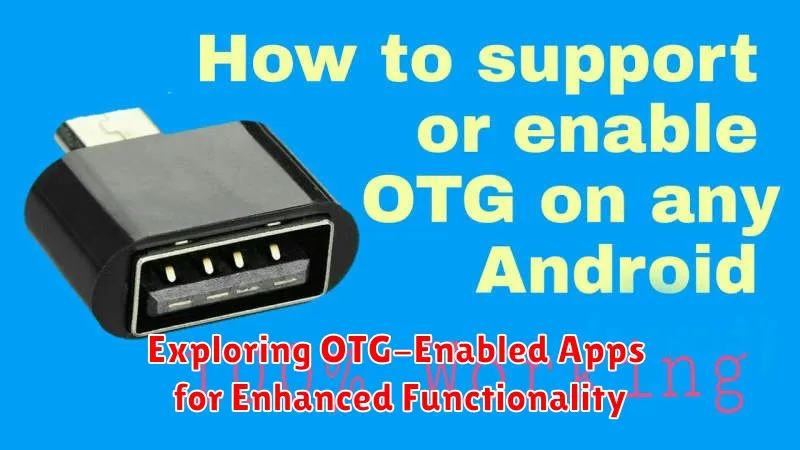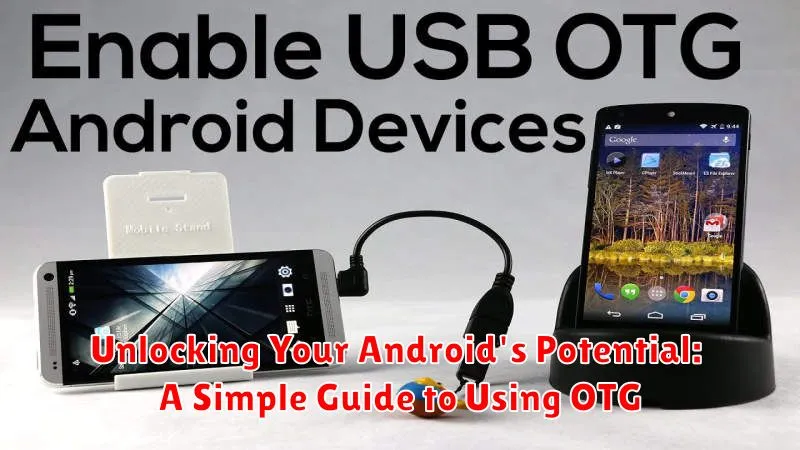Do you want to expand the functionality of your Android device? OTG, or On-The-Go, technology allows you to connect a wide range of peripherals directly to your Android phone or tablet. This simple guide will unlock your Android’s hidden potential by providing you with a clear understanding of how to use OTG. From connecting a USB drive for expanded storage to using a keyboard and mouse for enhanced productivity, OTG opens up a world of possibilities.
This comprehensive guide is designed for users of all experience levels. Whether you’re a tech novice or a seasoned Android enthusiast, understanding OTG can significantly improve your mobile experience. Learn how to check for OTG compatibility, choose the right OTG adapter, and troubleshoot common OTG issues. Discover the myriad of OTG accessories you can use and start unlocking your Android’s potential today.
Understanding OTG and Its Benefits
OTG, or On-The-Go, is a powerful standard that allows your Android device to act as a host for other USB devices. This means you can connect a wide range of peripherals and storage devices directly to your phone or tablet, expanding its functionality significantly.
Think of it as turning your Android device into a mini-computer. Instead of transferring files to and from your device via a computer, OTG lets you connect directly to a USB drive, accessing your files instantly. This direct access saves time and simplifies tasks like viewing photos, watching movies, or working on documents.
Beyond storage, OTG opens up a world of possibilities by enabling connections with peripherals. Imagine using a full-sized keyboard and mouse for more comfortable typing, or connecting a game controller for a superior gaming experience, all directly to your Android device.
Checking OTG Compatibility on Your Android Device
Before you get started with OTG, it’s essential to verify if your Android device supports it. There are a few ways to check compatibility.
Method 1: Physical Check (Less Reliable)
Some older devices have a micro-USB port designed specifically for OTG. Look closely at the port. If you see a small trapezoid shape next to the main rectangle, it might indicate OTG support. This isn’t foolproof, as some manufacturers use the same port design regardless of OTG capability.
Method 2: Using a Third-Party App
The most reliable method is to use an app designed to detect OTG support. Many free apps are available on the Google Play Store. Search for “OTG checker” and download a reputable option. These apps will quickly tell you whether your device is OTG compatible.
Method 3: Checking Manufacturer Specifications
You can also check the manufacturer’s website or product documentation. Look up your device’s specifications; the information should be listed there. Searching online forums dedicated to your specific device can also be helpful.
Connecting Your Device with an OTG Cable
Once you’ve confirmed your Android device’s OTG compatibility, the physical connection process is straightforward. You’ll need an OTG cable, which is readily available online or at electronics stores. One end of the OTG cable has a male micro-USB or USB-C connector (depending on your phone’s port) while the other end has a female USB-A connector.
Simply plug the male end of the OTG cable into your Android device’s charging port. Then, connect your USB drive, peripheral, or other compatible device into the female USB-A port on the OTG cable.
Upon successful connection, you should see a notification on your Android device indicating that a USB device has been connected. If you don’t see a notification, check your file manager app, which should now display the connected device.
Accessing Files on USB Drives and Other Devices
Once your USB drive or other storage device is connected via the OTG cable, your Android device should automatically detect it. A notification will usually appear indicating a successful connection. Accessing the files is generally straightforward.
Most Android devices use a file manager app to handle external storage. This app might be pre-installed or you might need to download one from the Google Play Store. Popular file managers include “Files by Google” and “Solid Explorer”.
Within the file manager, look for a section representing your connected USB drive. It will typically be labeled with the drive’s name or as “USB Storage”. Tapping on this section will open it, allowing you to browse the files and folders just as you would on your computer.
From there, you can perform various actions like copying, moving, deleting, and renaming files. You can also open files directly, provided you have compatible apps installed on your device.
Important Note: Always safely eject or unmount your USB drive before disconnecting it from your Android device. This prevents data corruption or loss. Look for an “eject” or “unmount” option within your file manager or in the notification area.
Using OTG for Peripherals (Keyboards, Mice, Game Controllers)
One of the most powerful features of OTG is the ability to connect peripherals like keyboards, mice, and game controllers directly to your Android device. This can transform your phone or tablet into a miniature workstation or gaming console.
Connecting a Keyboard: Simply plug in a USB keyboard using your OTG adapter. You can then use the keyboard for typing in documents, emails, and messages. This is particularly useful for longer writing tasks where the on-screen keyboard can feel cumbersome.
Connecting a Mouse: A USB mouse connected via OTG provides a familiar point-and-click interface. A cursor will appear on your screen, allowing for precise navigation and selection, much like using a traditional computer.
Connecting a Game Controller: Many Android games support external controllers. Connecting a game controller via OTG can greatly enhance your gaming experience, offering more precise controls and a more console-like feel.
Important Note: While most peripherals are plug-and-play, some might require specific drivers or configuration. Check the manufacturer’s instructions if you encounter any issues.
Troubleshooting Common OTG Issues
Occasionally, you might encounter issues when using OTG. This section covers some common problems and their solutions.
Device Not Recognizing OTG Device
Check the OTG cable: Ensure the cable is functioning correctly. Try a different cable if possible. Check the peripheral: Test the peripheral on another device to rule out a problem with the peripheral itself. Restart your device: A simple restart can sometimes resolve connection issues.
Insufficient Power
Some devices might not provide enough power for certain peripherals. Use a powered USB hub: A powered hub can provide the necessary power for demanding devices. Reduce power consumption: Close unnecessary apps or reduce screen brightness to conserve power.
File Format Incompatibility
Your Android device may not support the file system of the connected drive. Reformat the drive: Reformatting the drive to a compatible file system like FAT32 or exFAT is often a solution. Use a file manager app: Some file manager apps offer broader file system support.
Advanced OTG Uses: Expanding Your Device’s Capabilities

Beyond the basics of connecting flash drives and peripherals, OTG opens up a world of advanced functionalities for your Android device. Gaming enthusiasts can connect controllers for a console-like experience, significantly enhancing gameplay. This allows for more precise control and a more immersive experience, particularly for complex games.
Musicians can leverage OTG to connect MIDI keyboards or other instruments directly to their Android devices. This transforms a phone or tablet into a portable music production studio, allowing for on-the-go composing and recording.
For professionals who need to give presentations, OTG allows connecting projectors or displays directly to your Android device. This eliminates the need for a laptop, simplifying setup and enhancing portability.
Transferring data between two Android devices is also streamlined with OTG. Connect the devices directly using an OTG cable to quickly and efficiently move large files without relying on cloud services or Wi-Fi.
Exploring OTG-Enabled Apps for Enhanced Functionality

While Android inherently supports numerous OTG functions, dedicated apps can further enhance your experience and unlock advanced features. These apps often provide more granular control and specialized functionalities not available through the standard Android interface.
File Managers designed for OTG offer a streamlined way to manage files between your device and external storage. Features like direct copying, moving, and deleting files on USB drives or external hard drives become significantly easier with these specialized apps. Look for file managers specifically advertising OTG compatibility in their descriptions.
Backup and Restore Apps can leverage OTG to simplify backing up your device data. Instead of relying on cloud storage or computer connections, these apps can directly back up your important files, photos, and videos to a connected USB drive. This provides a fast and convenient offline backup solution.
Media Players optimized for OTG often support a wider range of video and audio codecs. They can directly access and play media files from external storage, bypassing the need to transfer files to internal storage, which can be particularly useful for large video files.

